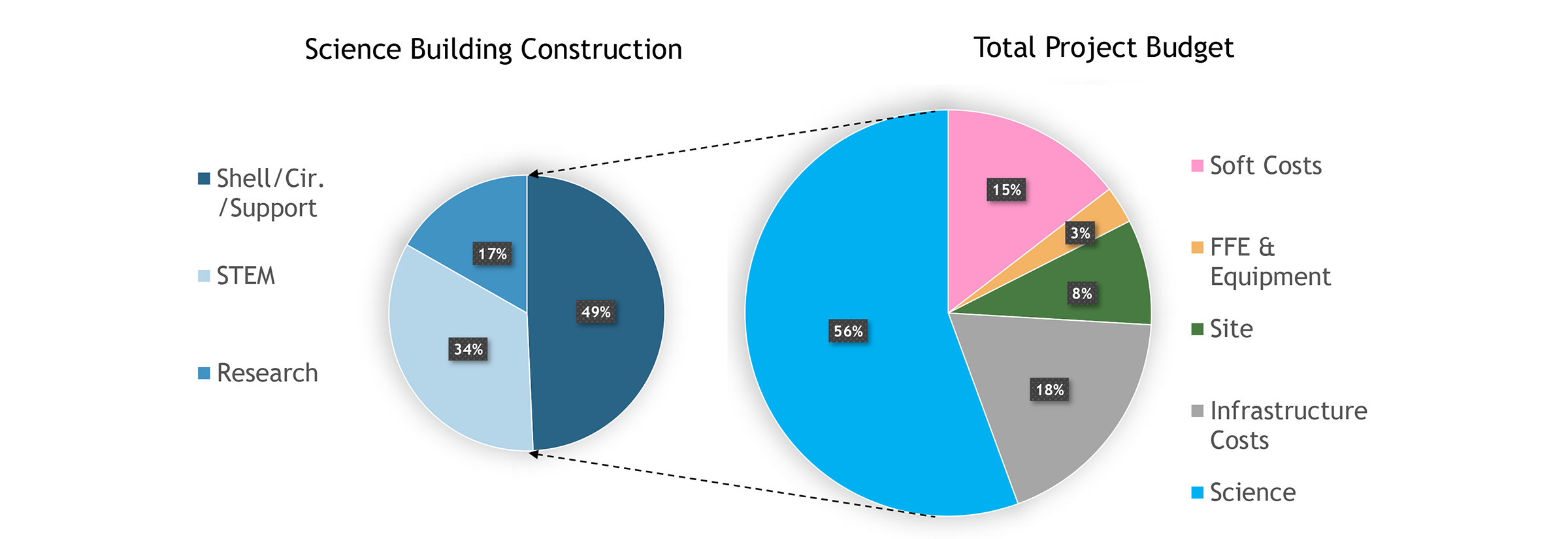Higher Education Design: Three Tips for Balancing a Large Mission & Limited Budget
Virtually every college or university has experienced the painful challenge of cutting project scope to meet budget limitations. Even seemingly large budgets, typically accompanied by equally significant project goals, can be quickly consumed. Featuring UNC Charlotte’s multidisciplinary new STEM building (currently nearing design completion) as a case study, the following blog explores how academic priorities can inform difficult facilities decisions.
w
The design of UNC Charlotte’s future multidisciplinary STEM instruction and research facility was undertaken with a hefty $90 million budget – but there was no question, from the earliest design phases, that integrating the numerous desired features and spaces would tax that budget. Following cost estimating that came in millions of dollars over budget, the team leveraged a well-established project vision and academic priorities to make the toughest decisions about what scope had to go. Their key takeaways for successfully navigating this experience include:
- Establish a clear, shared vision and prioritized goals for the project
- Involve key stakeholders early and often in a collaborative manner
- Manage expectations and encourage problem-solving
Establishing A Clear Project Vision
UNC Charlotte identified the need for a significant new science building as long ago as 2006, providing ample time to develop a clear vision and goals for the project. The university’s initial request to the North Carolina legislature was for $120 million – a budget informed by several studies demonstrating significant need on campus. In 2016, the passage of the Connect NC Bond dedicated $1 billion in funds to STEM education projects, including $90 million for UNC Charlotte’s new facility. A 2014 study revealing overcrowded instructional labs, a lack of research space, and a severely outdated chemistry building provided key insights as university stakeholders weighed emerging pedagogy and educational trends to shape the vision for this project.
The resulting project vision and goals center on a multidisciplinary instructional experience for students. In particular, UNC Charlotte’s leadership emphasized the supportive and interdisciplinary role of foundational courses in STEM disciplines. The programming effort creates an interdisciplinary teaching and research science center for chemistry, biology, and physics. State-of-the-art learning environments including a TEAL classroom, opportunities for graduate and undergraduate research, and formal and informal collaboration spaces accommodate peer-to-peer and project-based learning.
The identification of interdisciplinary instructional space as a core tenet of the program would prove invaluable. After an extensive value engineering effort, the project team recognized that getting within budget would require a painful choice: eliminating the multidisciplinary elements and cutting the facility to one discipline; cutting instructional laboratory space; or reducing the amount of research space. Guided by a vision rooted in academic priorities, university leadership determined that reducing the amount of square footage for research was the most acceptable solution. This decision reflects the importance of prioritizing project goals; in this case, the number one priority was to establish an instructional space for students that fosters interaction between scientific disciplines.
Collaboration & The Role of Key Stakeholders
A large project comes with a large group of stakeholders. Involving leadership, facilities personnel, end users such as faculty and students, and experts from design and construction is critical to designing a facility that ultimately functions at the highest level. UNC Charlotte’s Director of Planning, Kathryn Horne, shared a few anecdotes and lessons learned from the project’s formative stages, noting the team’s nationwide tour of cutting-edge STEM education facilities. In her words, seeing those environments first hand, together, helped establish a strong team chemistry that was critical in overcoming the budget challenges that followed later.
Equally significant in Kathryn’s mind is the importance of giving faculty – who have taught in a certain way in a certain environment for years – the opportunity to be exposed to innovative new space types and grasp how those spaces can be used. “Change is hard,” she acknowledged, going on to speak to the role of faculty in defining how new spaces and new technology can work best in practice.
Through a collaborative process that engaged all stakeholders early, the project team: Clark Nexsen (architect of record), Payette (design architect), Vanderweil Engineers, Balfour Beatty Construction, and UNC Charlotte) established the central vision for the project and quickly recognized the likelihood of a budget shortfall. The project’s lofty goals and expansive program were reflective of the originally-requested $120 million and would require some innovative problem-solving to meet the final budget.
During early cost estimating, the disparities between the targeted design and the budget rapidly became apparent, and Balfour Beatty worked hard to foster a positive, collaborative environment in which to discuss possible solutions. In particular, they drilled down on specific cost drivers to provide accurate information for UNC Charlotte’s facilities personnel and leadership. This effort revealed which project components were driving the greatest costs and enabled informed decisions based on the project’s goals.

As shown in the charts above, nearly 50 percent of the total project budget is consumed by infrastructure, site, FF&E, and soft costs, leaving in the neighborhood of $50 million for the science building itself. Additionally, while many STEM education buildings are a balance of classroom, lab, office, and collaboration space, UNC Charlotte’s building has a heavier balance of labs – a priority in the design, but more expensive to build.
Managing Expectations & Focusing on Problem-Solving
As Annie Hughes of Balfour Beatty put it, everyone was unpleasantly surprised by the cost figures. Between an extensive building program, the accompanying utility plant and data center, and unexpectedly high site costs, the project was significantly over budget. The key to navigating this circumstance, in Annie’s words, is to avoid the blame game. Balfour Beatty’s approach was to provide as much insightful and granular cost data as possible, supporting UNC Charlotte in identifying the major cost drivers and defining “needs” versus “wants” for the new building.
A team mentality and honest approach led to the three previously mentioned solutions to align the scope and budget: eliminating the interdisciplinary aspect, cutting instructional lab space, or reducing research space. While none were attractive alternatives, the university opted to reduce the amount of space dedicated to research – a decision that is in keeping with the academic priorities for the facility, which emphasize interdisciplinary education. Simultaneously, they were also able to develop a plan to accommodate additional chemistry research elsewhere on campus.
In the big picture, the design of the new, multidisciplinary STEM building is representative of a turning point for UNC Charlotte. The opportunity for interdisciplinary education is expected to invigorate the learning experience for students in STEM majors and have a transformative impact on campus. Guided by that academic priority, the team was able to navigate the delicate balance between aspirations and budget to design an eagerly-anticipated new facility.

Kevin Utsey, FAIA, LEED AP BD+C, is a principal and architectural department head in Clark Nexsen’s Charlotte office. With more than 37 years of design experience, he specializes in creating meaningful spaces for people to gather, work, and learn. To speak with Kevin, please call 704.377.8800 or email kutsey@clarknexsen.com.
“Large Mission and Limited Funds: Academic Priorities Drive Facilities Decisions” was originally presented at the Society for College and University Planning (SCUP) Southern Conference 2018. Kevin Utsey was joined by fellow presenters Kathryn Horne of UNC Charlotte, Donia Schauble of UNC Charlotte, and Annie Hughes of Balfour Beatty Construction.
Top photograph by Mark Herboth.

